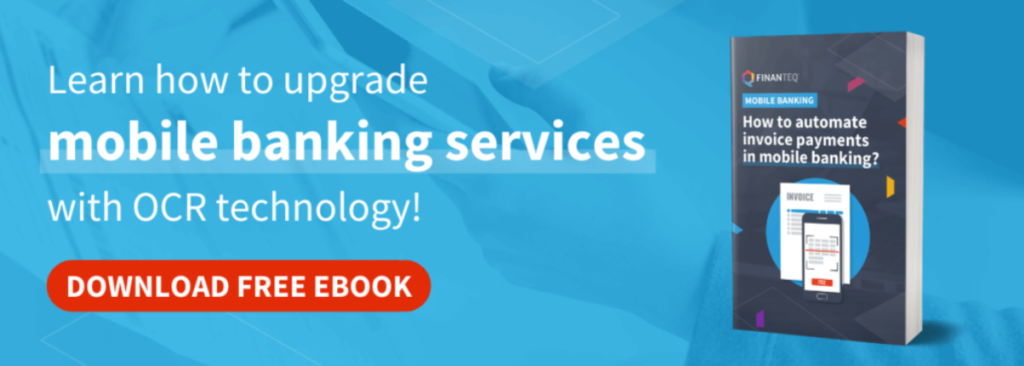
Agnieszka Torój
Finanteq company
Author

The banking industry should emphasize implementing new technologies into its products and services, and OCR technology is a must-have. OCR has been around for years and is used in widespread situations. To start with behind-the-scenes operations and finish with end-user support. One of the best examples of how OCR technology helps the user in everyday matters is the document scanning component embedded in the mobile banking app. Who among us does not have to pay invoices? With OCR technology, even this activity can be pleasant and convenient.
What is Optical Character Recognition?
From the outset.
Optical Character Recognition (OCR) based on Artificial Intelligence (AI) is a software solution allowing users to convert typed or handwritten text images into machine-readable data.
Optical Mark Recognition (OMR) is another offshoot of image recognition technology
worth mentioning here. It relies on gathering manual-typed data by recognizing specific markings on a document. The solution is broadly implemented in various industries.
Has the OCR technology market significant potential?
Sure it has! The importance of OCR technology is crucial, especially for the financial industry.
According to the latest report, the OCR market will reach a value of USD 39,655 million by 2030 at a CAGR of 16% during the next eight years.
Source: www.globenewswire.com
There is no doubt that OCR solutions are on the rise.
In today’s electronic world, digital data dominates. But there are and will continue to be for some time to come, undeveloped areas that rely on paper-based information transfer. OCR becomes, so to speak, the ‘connector’ of these two worlds, making users’ lives easier. Habituation to the digital world is already so strong that it seems natural that modern solutions can combine these two worlds while taking care of a good user experience.
Invoice scanning – a must-have in every modern banking app
An in-app invoice scanning tool embedded in the mobile banking app is essential.
Why?
First, direct bank transfers via the mobile application can be inconvenient when the user has to do it manually. However, invoice scanning becomes a piece of cake when the app has the OCR feature. Thanks to OCR, banks’ customers can spend less time on data entry thanks to this technology. Moreover, it allows them to perform transfers everywhere. All they need is to have the invoice in front of them.
The above factors make customers pay invoices in the mobile app more willingly, which results in a higher number of transactions on a bank-wide basis. At the end of the day, the bank gains customer loyalty.
As the invoice payment process is less error-prone, this translates into lower customer service costs for banks.
Both customers and banks benefit.
What are the most common examples of OCR technology use?
Thanks to the implementation of the OCR, which instantly captures invoice data, the smartphone camera is all the user needs to make a payment.
OCR document scanning is the best app’s user assistance with paper and electronic invoices.
The first and most common use case is paper invoice scanning with OCR technology. The bank’s customer photographs the invoice with a smartphone. Thanks to its OCR component, the mobile banking app extracts the relevant data from the photo and intelligently uses it to prepare the transfer form. Easy and simple!
Next, let’s move on to the case of payment for electronic invoices. The customer opens the downloaded file or e-mail attachment invoice using the mobile application. The app automatically copies and fills in necessary data from the document into the transfer form. There is no need to jump around between applications. That’s a significant improvement.
Additionally, the OCR for Invoice Payments component validates the accuracy of most inserted data, such as bank account numbers and VAT identification numbers.
That is a significant improvement in the invoice payment process.
For specific use cases, download our OCR for Invoice Payments Product Overview.

To sum up
Mobile forms, especially banking transfer forms, have a variety of fields to be filled in correctly, making the copy-paste process uncomfortable and problematic. Moreover, manually typing in data increases the risk of errors and is a poor process in terms of user experience.
Fortunately, banks can implement OCR solutions, which makes the invoice payments process much more manageable.
The tool’s main benefits are that it saves time, minimalizes customer effort, and maximizes customer satisfaction.
Considering implementing OCR in your bank? Contact us now at https://finanteq.com/contact/









